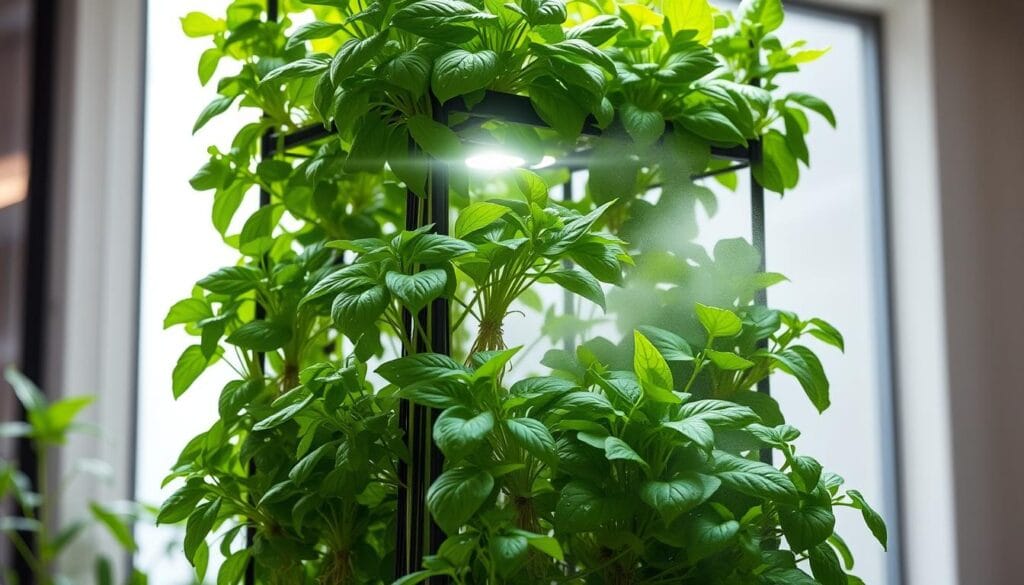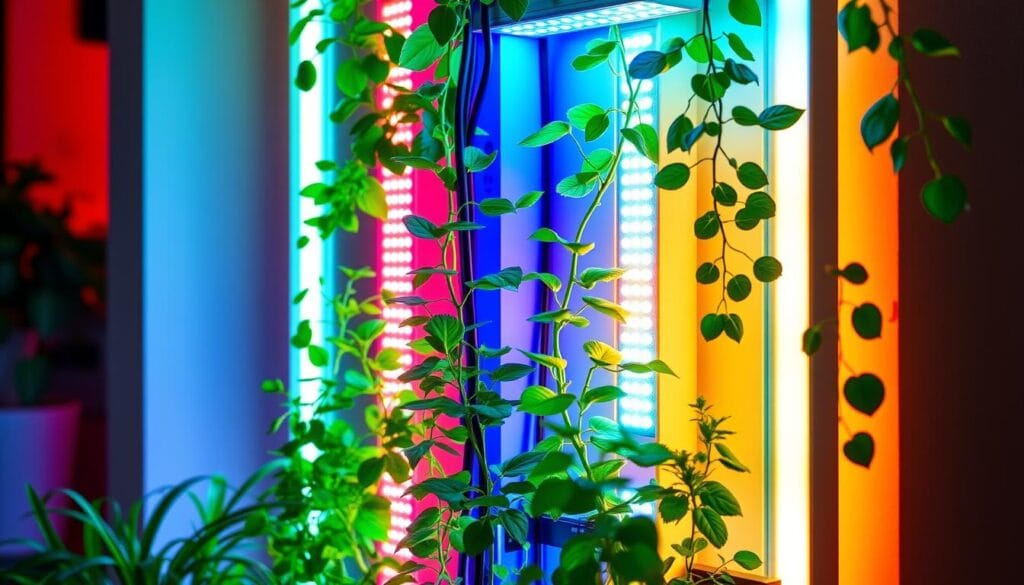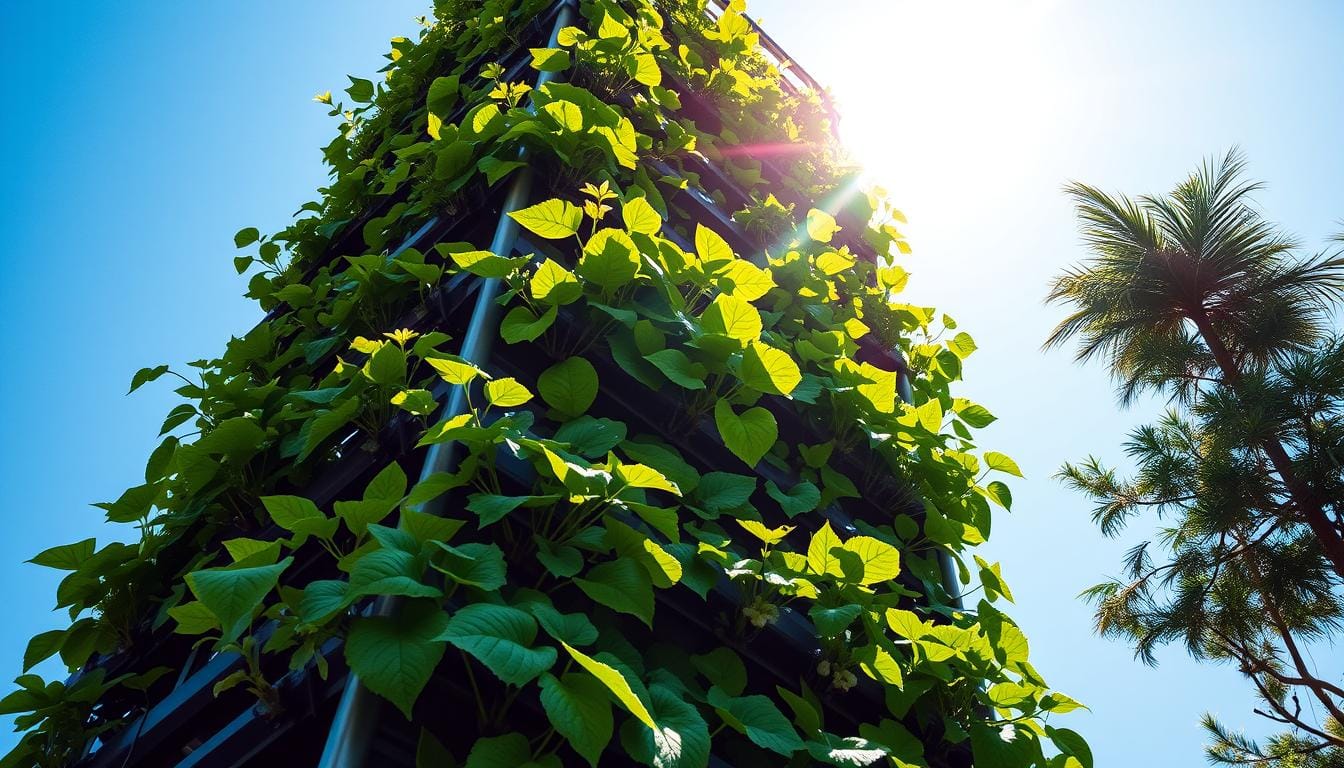Supercharge yields and create a lush, verdant oasis in your home, where greens and fruits thrive without soil. Vertical garden towers make this dream a reality, offering a revolutionary way to garden and transform how you grow food
I’ve always been drawn to growing food myself, in a way that’s good for the planet. Aeroponic and hydroponic gardening, inspired by ancient wonders like the Hanging Gardens of Babylon, show us a future. In this future, city folks can grow lots of food, even with little space or bad weather.
Key Takeaways:
- Vertical garden towers enable high-density, space-efficient food production.
- Aeroponically grown plants can absorb more oxygen for faster, healthier growth.
- Hydroponic systems use 90% less water than traditional soil-based gardening.
- Aeroponic towers can grow a variety of crops, including leafy greens, herbs, and fruiting vegetables.
- DIY and commercial aeroponic tower systems are available to suit different budgets and needs.
Understanding Vertical Garden Tower Systems
Gardening has changed a lot with vertical growing systems. These new ways of growing plants are great for city gardeners, people with little space, and nature lovers. They use new ideas like hydroponics to grow plants in a way that’s good for the planet and saves space.
Evolution of Soilless Gardening
Soilless gardening has been around for a long time. Ancient people used hydroponics and floating gardens. Now, we have new ways to grow plants without soil, like vertical gardens. These systems use hydroponics and other methods to give plants what they need, saving space and water.
Benefits of Vertical Growing Systems
Vertical garden towers have many benefits. They use much less water than regular gardens, up to 90%. They also don’t need pesticides because they’re a controlled space. Plus, they make the most of small spaces, letting people in cities or with tiny yards grow lots of different plants.
Modern Hydroponic Innovations
New hydroponic tech has made vertical gardening better. Now, we have systems that automatically feed plants, use LED lights, and stack plants up. This means we can grow food faster, up to 40-50% quicker than before. Vertical gardens are now a key part of growing food in cities and places with little land.
“Vertical gardening maximizes the use of limited space, making it ideal for urban dwellers or those with small yards or balconies.”
Essential Components for Building Your Tower Garden
Building a DIY vertical garden tower needs several key parts for the best plant growth. These parts include the growing medium, water, and nutrients. Each part is vital for a thriving hydroponic system.
Growing Mediums
The base of your tower garden is the growing medium. You can choose from coconut coir, peat, and mineral wool. Each has its own benefits for different plants and growing conditions.
The right growing medium depends on the plant’s pH, nutrient needs, and specific requirements. It’s important to pick the best one for your plants.
Nutrient Solutions
It’s crucial to give plants the right mix of nutrients for growth. You can make nutrient solutions that fit your plants’ needs. This guarantees that the plants receive the necessary nutrients for optimal and healthy growth.
Water and Oxygen Supply
A good water and oxygen system is key for a healthy hydroponic system. You’ll need air pumps, air stones, and water areas for oxygen. Also, a reliable water supply and recirculation system are important.
Lighting Options
For indoor gardens, the right grow lights are vital. They provide the light spectrum and intensity plants need. LED, fluorescent, or metal halide bulbs can be placed to ensure even light.
By choosing and combining these essential parts, you can make a very effective vertical garden tower. It will boost your yields and bring gardening joy to your space.
Supercharge Yields Tower Garden: Advanced Growing Techniques
To grow a thriving tower garden, you need more than just the structure. Mastering advanced growing techniques is key. This includes managing nutrients, adjusting light, and controlling the environment. These steps can help your vertical garden reach its full potential.
Nutrient Solution Management
Creating a nutrient solution that’s just right for your plants is crucial. Adjust the plant nutrients as your plants grow. Keep an eye on pH and EC levels to ensure your plants get the right food for growth.
Light Optimization Strategies
Lighting is vital for a healthy controlled environment agriculture. Play with light intensity, spectrum, and duration to match your plants’ needs. This can boost photosynthesis and help your plants grow faster and stronger.
Temperature and Humidity Control
Keeping the right temperature and humidity is key for year-round growth. Use advanced systems to control these factors in your tower garden. This ensures your plants thrive, no matter the weather outside.
With these advanced techniques, your tower garden will flourish. You’ll enjoy a constant supply of fresh produce and a vibrant indoor space.
| Vertical Garden System | Yield Capacity |
|---|---|
| Lettuce Grow Farmstand | Up to 12 heads of lettuce per level |
| Gardyn Home Kit 3.0 | 12 pre-loaded plant pods |
| Nutraponics Hydroponics Tower | Up to 48 plant levels |
| Aerospring 27-Plant Vertical Hydroponics System | 27 leafy greens, herbs, and microgreens |
“Plants grown hydroponically develop roots and grow at a rate that is 40–50% faster compared to those cultivated in soil.”
Choosing the Right Growing Medium
Choosing the right growing medium is key for a successful vertical aeroponic garden or hydroponic system. Unlike traditional soil gardening, these systems use special substrates. These substrates provide support, aeration, and nutrients to plants. The right medium can boost your yields and keep your vertical garden healthy.
Popular growing mediums include:
- Coconut coir – This eco-friendly material holds water well and fights off fungi, making it a top choice for many.
- Peat – Made from sphagnum moss, peat controls moisture and aeration for roots.
- Perlite – A volcanic glass that improves drainage and aeration, often mixed with coco coir or peat.
- Mineral wool – Known as rockwool, it holds water and nutrients well.
- Growstone – Made from recycled glass, it offers great aeration and drainage.
The right medium depends on your plants, water pH, and system design. For instance, some plants love coco coir’s slightly acidic environment. Others do better in neutral mediums like perlite or mineral wool.
Some aeroponic systems, like advanced tower gardens, don’t need a medium. They use water solution, light, and air for plant nourishment. This makes them a soil-free way to garden vertically.

It’s crucial to watch the pH, nutrient levels, and health of your vertical garden. This ensures your plants grow well and yield great results.
Water and Nutrient Management Systems
Keeping the right balance of water and nutrients is key for a thriving vertical garden. Understanding how to manage these elements can boost your plant growth. It also keeps your vertical garden healthy for a long time.
Reservoir Setup and Maintenance
Choose a reservoir that fits your vertical garden’s needs. This helps avoid often refilling and adjusting nutrients. A submersible pump circulates the nutrient solution to the misting nozzles. This ensures plants get the nutrients they need.
pH Balance and EC Monitoring
Keep an eye on your nutrient solution’s pH and electrical conductivity (EC). Aeroponic plants do best in a pH of 5.5-6.5. This helps them absorb nutrients well. The right EC levels mean your plants get the nutrients they need for strong growth.
Nutrient Solution Recipes
- Make your nutrient solution recipes fit your crops’ needs or growth stages.
- Use a complete, balanced fertilizer made for hydroponic or aeroponic systems.
- Flush your system every two weeks to avoid nutrient buildup and keep growing conditions perfect.
| Nutrient | Aeroponic | Hydroponic |
|---|---|---|
| Nitrogen (N) | 150-200 ppm | 100-150 ppm |
| Phosphorus (P) | 50-80 ppm | 40-60 ppm |
| Potassium (K) | 150-200 ppm | 150-200 ppm |
By following these tips for water and nutrient management, your vertical garden tower will thrive. It will grow plants well and give great yields.
Lighting Requirements and Setup
Proper lighting is key for a successful indoor controlled environment agriculture setup. When choosing grow lights, consider light intensity, spectrum, and duration. LED lights are popular for their energy savings and adjustable spectrum.
To set up your lighting, place the lights about 12 inches above your plants. Adjust the height as your plants grow. This ensures they get the right amount of light without stress. Use timers to automate light cycles, mimicking natural day and night.
- Choose LED grow lights for their energy efficiency and customizable spectrum
- Position lights about 12 inches above plants and adjust as needed
- Use timers to automate light cycles and simulate natural photoperiods
Proper lighting is essential for maximizing yields in your indoor controlled environment agriculture setup. By understanding and optimizing your lighting requirements, you can create the ideal growing conditions for your plants and unlock their full potential.

Space-Efficient Design Strategies
Urban farming fans looking to grow more in small spaces can use vertical aeroponic gardening. Vertical garden towers are a great choice, needing only two square feet of space. They offer a big growing area. These systems are made of modular parts, making it easy to add or change things as needed.
Vertical Stacking Techniques
When setting up your vertical garden tower, think about how to use space well. Arrange the tiers so they get enough light and are easy to reach. This way, you can make a beautiful and productive garden in a small area.
Modular System Components
Modular parts are a big help for urban farmers. They let you grow more as your needs change. Whether you start small or want to grow a lot, you can add more tiers or features like automated systems easily.
| Vertical Garden Tower Specifications | Smart Farm Hydroponic Tower |
|---|---|
| Footprint (square feet) | 2 |
| Growing Tiers | 7 |
| Warranty on Functional Parts | 1 year |
| Pump Cord Length (meters) | 5 |
| Maximum Pump Height (meters) | 2 |
| Backup Battery for Solar Option | Available late 2020 |
By using these design tips, urban farmers can make the most of their space. Vertical garden towers can be very productive, even in tiny areas. With modular parts and smart stacking, the possibilities for vertical aeroponic gardening are endless.
Plant Selection and Crop Planning
Starting your urban seed starting or urban farming project needs careful plant choice and crop planning. Pick plants that do well in hydroponic systems, like leafy greens, herbs, strawberries, and small fruiting plants.
Plan your crop rotations to get a full harvest all year. Think about growth speed, nutrient needs, and when to harvest. Try different varieties to see what works best in your hydroponic setup.
For optimal growth, most vegetables require at least 6 hours of sunlight daily. A 3×3 meter area is great for beginners and can grow up to five veggies. For example, you might eat about 180 onions for half the year, and around 270 onions a year.
Perennials like asparagus, strawberries, rhubarb, and kale need little care once they’re set up. They’re perfect for your urban farming project. But, citrus, peaches, figs, and pomegranates need special soil and climate, so they need more care.
| Crop | Yield Potential | Nutrient Requirements | Harvest Frequency |
|---|---|---|---|
| Tomatoes | High | Moderate | Ongoing |
| Leafy Greens | High | Low | Frequent |
| Herbs | Moderate | Low | Frequent |
| Strawberries | Moderate | Moderate | Ongoing |
By choosing the right plants and planning your crops, you can make a thriving urban farming system. It will give you fresh, healthy food all year.
Maintenance and Troubleshooting Guide
Keeping your vertical garden tower healthy needs a regular care plan. This ensures the best growing conditions and avoids common problems. It’s important to check nutrient levels, look for pests and diseases, and act fast to fix issues.
Common Issues and Solutions
Nutrient deficiencies are a big challenge in vertical gardens. Watch the pH and electrical conductivity (EC) of your nutrient solution closely. If you find any imbalances, adjust the nutrients or flush the system to fix it.
Root rot is another issue, often caused by wrong misting timing. Clean the misting nozzles and keep moisture right to avoid this. Check the roots for color changes or decay and act quickly if you see any problems.
Regular Maintenance Schedule
- Check and adjust nutrient solution levels weekly
- Clean misting nozzles and inspect for clogs monthly
- Test the pH and EC of the nutrient solution bi-weekly
- Thoroughly flush the system every 4-6 weeks to prevent mineral buildup
- Inspect plants for pests or diseases on a regular basis
- Prune and maintain plant growth as needed
Stick to a regular maintenance plan and solve problems quickly. This way, your vertical garden tower will keep growing well and give you plenty of fresh, healthy food all year. A bit of care and attention will make your controlled environment agriculture setup reliable for fresh produce.
Maximizing Year-Round Production
Vertical garden towers let you grow food all year, even when it’s cold outside. You can change the light, temperature, and nutrients to match each season. This way, you can always have fresh food from your garden.
To keep your garden going strong, use heat mats or coolers in extreme weather. Plan your planting to switch between fast-growing greens and slower-growing fruits. This mix keeps your garden busy and your table full.
| Feature | Specification |
|---|---|
| Warranty | 1-year warranty on functional parts |
| Money-back Guarantee | 30-day money-back guarantee for quality results |
| Reservoir Capacity | 60-liter reservoir, needs refilling every 2 weeks |
| Timer | 24-hour timer in 15-minute increments |
| Pump | Solar pump can push water above 2 meters high without backup battery |
By paying attention to your plants’ needs and using your vertical garden’s features, you can make the most of year-round urban farming and controlled environment agriculture. This system is flexible and precise, leading to a constant supply of fresh produce.
“The beauty of vertical gardening is that it allows me to grow a diverse array of crops in a compact space, no matter the season. It’s a game-changer for urban farming.”
Conclusion
Building and optimizing your DIY vertical garden tower has been exciting. It’s filled with the promise of better yields and embracing urban farming’s future. You’ve used advanced growing techniques like hydroponics and aeroponics. This has opened up a world where your garden can grow well, even in small spaces.
Vertical aeroponic gardening is a green and efficient way to grow food. It tackles the big issues of growing cities and caring for our planet. With the right setup, nutrients, and plants, you can get lots of fresh, healthy food right in your backyard or city spot.
Keep making your tower garden better by staying curious and open to change. Watch your system closely, make tweaks, and fix any problems. This will keep your vertical garden thriving for a long time. Enjoy the journey, celebrate your wins, and inspire others to join you in urban farming.

